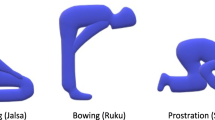Abstract
Purpose
The aim was to study possible differences of muscle injuries regarding type, localization and the extent of injury between the dominant and non-dominant leg in elite male football players. Another aim was to study the injury incidence of muscle injuries of the lower extremity during match and training.
Methods
Data were consecutively collected between 2007 and 2013 in a prospective cohort study based on 54 football players from one team of the Swedish first league. The injury incidence was calculated for both match and training, injuries to the hip adductors, quadriceps, hamstrings and triceps surae were diagnosed and evaluated with ultrasonography, and their length, depth and width were measured to determine the extent of structural muscle injuries.
Results
Fifty-four players suffered totally 105 of the studied muscle injuries. Out of these 105 injuries, the dominant leg was affected in 53 % (n = 56) of the cases. A significantly greater extent of the injury was found in the dominant leg when compared with the non-dominant leg with regard to structural injuries of the hamstrings. No other significant differences were found.
Conclusions
Structural hamstring muscle injuries were found to be of greater extent in the dominant leg when compared with the non-dominant leg. This new finding should be taken into consideration when allowing the football player to return to play after leg muscle injuries.
Level of evidence
IV.

Similar content being viewed by others
References
Askling CM, Tengvar M, Saartok T, Thorstensson A (2007) Acute first-time hamstring strains during high-speed running: a longitudinal study including clinical and magnetic resonance imaging findings. Am J Sports Med 35:197–206
Connell DA, Schneider-Kolsky ME, Hoving JL et al (2004) Longitudinal study comparing sonographic and MRI assessments of acute and healing hamstring injuries. AJR Am J Roentgenol 183:975–984
Daneshjoo A, Rahnama N, Mokhtar AH, Yusof A (2013) Bilateral and unilateral asymmetries of isokinetic strength and flexibility in male young professional soccer players. J Hum Kinet 36:45–53
Douis H, Gillett M, James SL (2011) Imaging in the diagnosis, prognostication, and management of lower limb muscle injury. Semin Musculoskelet Radiol 15:27–41
Dudley-Javoroski S, McMullen T, Borgwardt MR, Peranich LM, Shields RK (2010) Reliability and responsiveness of musculoskeletal ultrasound in subjects with and without spinal cord injury. Ultrasound Med Biol 36:1594–1607
Ekstrand J, Askling C, Magnusson H, Mithoefer K (2013) Return to play after thigh muscle injury in elite football players: implementation and validation of the Munich muscle injury classification. Br J Sports Med 47:769–774
Ekstrand J, Healy JC, Waldén M, Lee JC, English B, Hägglund M (2012) Hamstring muscle injuries in professional football: the correlation of MRI findings with return to play. Br J Sports Med 46:112–117
Ekstrand J, Hägglund M, Waldén M (2011) Epidemiology of muscle injuries professional football (soccer). Am J Sports Med 39:1226–1232
Ekstrand J, Hägglund M, Waldén M (2011) Injury incidence and injury patterns in professional football: the UEFA injury study. Br J Sports Med 45:553–558
Fuller CW, Ekstrand J, Junge A et al (2006) Consensus statement on injury definitions and data collection procedures in studies of football (soccer) injuries. Clin J Sport Med 16:97–106
Hägglund M, Waldén M, Bahr R, Ekstrand J (2005) Methods for epidemiological study of injuries to professional football players: developing the UEFA model. Br J Sports Med 39:340–346
Hägglund M, Waldén M, Ekstrand J (2013) Risk factors for lower extremity muscle injury in professional soccer: the UEFA Injury Study. Am J Sports Med 41:327–335
Hölmich P, Thorborg K, Dehlendorff C, Krogsgaard K, Gluud C (2014) Incidence and clinical presentation of groin injuries in sub-elite male soccer. Br J Sports Med 48:1245–1250
Järvinen TA, Järvinen TL, Kääriäinen M et al (2007) Muscle injuries: optimising recovery. Best Pract Res Clin Rheumatol 21:317–331
Järvinen TA, Järvinen TL, Kääriäinen M, Kalimo H, Järvinen TL (2005) Muscle injuries: biology and treatment. Am J Sports Med 33:745–764
Mueller-Wohlfahrt HW, Haensel L, Mithoefer K et al (2013) Terminology and classification of muscle injuries in sport: the Munich consensus statement. Br J Sports Med 47:342–350
Nikolaou PK, Macdonald BL, Glisson RR, Seaber AV, Garrett WE (1987) Biomechanical and histological evaluation of muscle after controlled strain injury. Am J Sports Med 15:9–14
Peetrons P (2002) Ultrasound of muscles. Eur Radiol 12:35–43
Slavotinek JP, Verrall GM, Fon GT (2002) Hamstring injury in athletes: using MR imaging measurements to compare extent of muscle injury with amount of time lost from competition. AJR Am J Roentgenol 179:1621–1628
Stoller DW (2007) Magnetic resonance imaging in orthopaedics and sports medicine, lower extremity, vol 1. Lippincott Williams & Wilkins, Baltimore
Takebayashi S, Takasawa H, Banzai Y et al (1995) Sonographic findings in muscle strain injury: clinical and MR imaging correlation. J Ultrasound Med 14:899–905
Acknowledgments
The Swedish Centre for Sport Research is gratefully acknowledged for financial support.
Author information
Authors and Affiliations
Corresponding author
Rights and permissions
About this article
Cite this article
Svensson, K., Eckerman, M., Alricsson, M. et al. Muscle injuries of the dominant or non-dominant leg in male football players at elite level. Knee Surg Sports Traumatol Arthrosc 26, 933–937 (2018). https://doi.org/10.1007/s00167-016-4200-4
Received:
Accepted:
Published:
Issue Date:
DOI: https://doi.org/10.1007/s00167-016-4200-4




